Preventive maintenance is crucial for businesses that rely on machinery and equipment to maintain smooth operations, reduce downtime, and manage costs effectively. Tracking maintenance schedules, equipment performance, and technician workload manually can be challenging and time-consuming.
A Preventive Maintenance Dashboard in Excel provides an organized, visual, and interactive solution for monitoring all aspects of preventive maintenance. This ready-to-use dashboard consolidates equipment data, maintenance schedules, costs, and technician performance in one central platform.
In this article, we’ll explore the features, benefits, and best practices for using a Preventive Maintenance Dashboard in Excel, and how it can enhance maintenance efficiency and decision-making.
What is a Preventive Maintenance Dashboard in Excel?
Click to Buy Preventive Maintenance Dashboard in Excel
A Preventive Maintenance (PM) Dashboard is an Excel-based tool designed to track and analyze all maintenance activities. The dashboard integrates data from maintenance schedules, costs, equipment details, and technician records, providing a comprehensive overview in real time.
With this dashboard, organizations can:
-
Monitor scheduled vs completed maintenance tasks.
-
Track maintenance costs by equipment, type, and frequency.
-
Identify overdue maintenance tasks to prevent breakdowns.
-
Analyze technician performance and workload.
-
Make data-driven decisions to optimize preventive maintenance strategies.
Key Features of the Preventive Maintenance Dashboard
Our Preventive Maintenance Dashboard in Excel includes multiple sheet tabs to provide detailed insights and allow for easy data management.
1. Overview Sheet Tab: High-Level Insights
The Overview Sheet serves as the main hub for all maintenance data, providing cards, charts, and equipment analysis.
Cards: Key Metrics
-
# of Equipment: Total number of equipment being tracked.
-
Total Cost: Overall maintenance expenditure.
-
Average Cost: Average maintenance cost per equipment or maintenance type.
-
Scheduled %: Percentage of scheduled maintenance completed.
-
# of Maintenance: Total number of maintenance activities recorded.
Charts: Visualize Maintenance Performance
-
Completed %: Displays overall completion rate of scheduled maintenance.
-
Completed vs Scheduled Maintenance by Frequency: Compares actual maintenance against planned maintenance by daily, weekly, monthly, or yearly schedules.
-
Overdue % by Maintenance Type: Highlights maintenance tasks that are overdue based on type.
-
# of Maintenance by Status: Shows the number of maintenance activities categorized by status (Completed, Pending, Overdue).
-
Total Cost by Month: Visualizes monthly maintenance expenses for budgeting and planning.
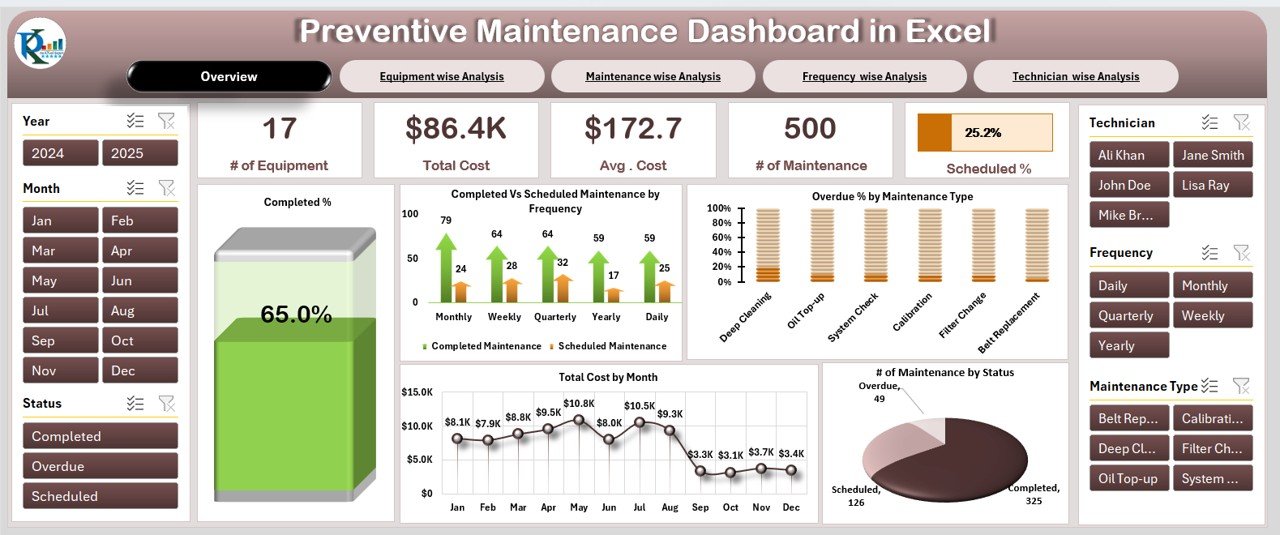
Click to Buy Preventive Maintenance Dashboard in Excel
2. Equipment-Wise Analysis
Understanding equipment performance is critical to preventing unplanned downtime and controlling costs. The dashboard provides equipment-specific insights through these charts:
-
Completed % by Equipment Name: Measures maintenance completion rate for each piece of equipment.
-
Total Cost by Equipment Name: Tracks expenses per equipment to identify high-cost assets.
-
# of Maintenance by Equipment Name: Counts maintenance activities for each asset.
-
Completed vs Scheduled Maintenance by Equipment Name: Highlights compliance with maintenance schedules for individual equipment.
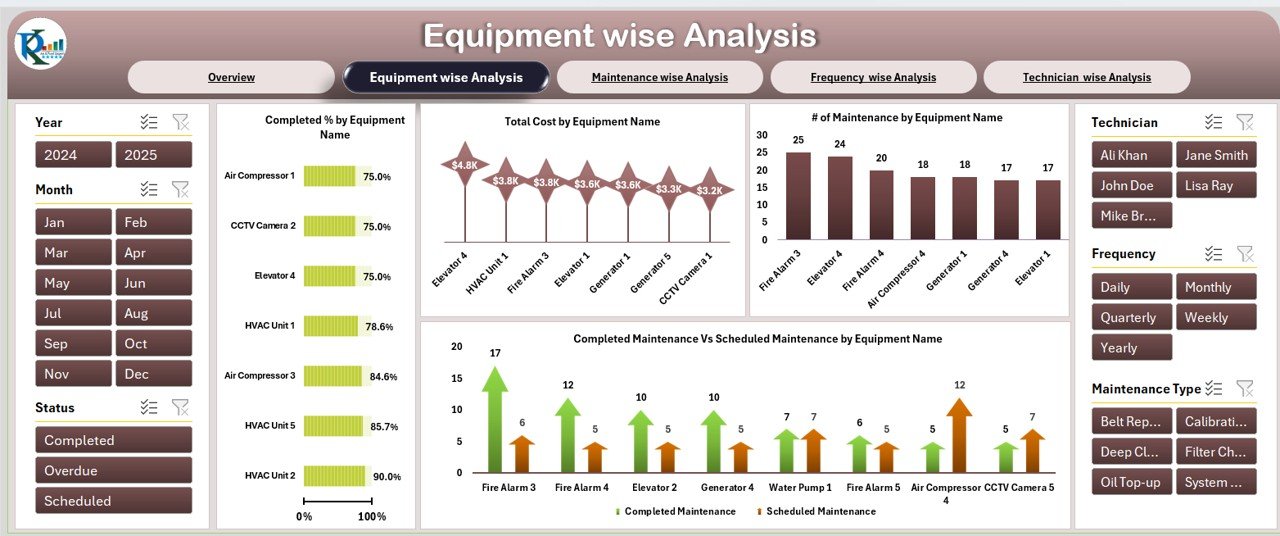
3. Maintenance-Wise Analysis
Maintenance activities vary in type (e.g., lubrication, inspection, calibration). Monitoring performance by maintenance type helps identify areas for improvement:
-
Total Cost by Maintenance Type: Tracks how much is spent on each type of maintenance.
-
Overdue Maintenance by Maintenance Type: Highlights overdue tasks by type for prioritization.
-
Completed Maintenance by Maintenance Type: Displays the number of completed maintenance activities by type.
-
Scheduled % by Maintenance Type: Shows the percentage of planned tasks completed per maintenance type.
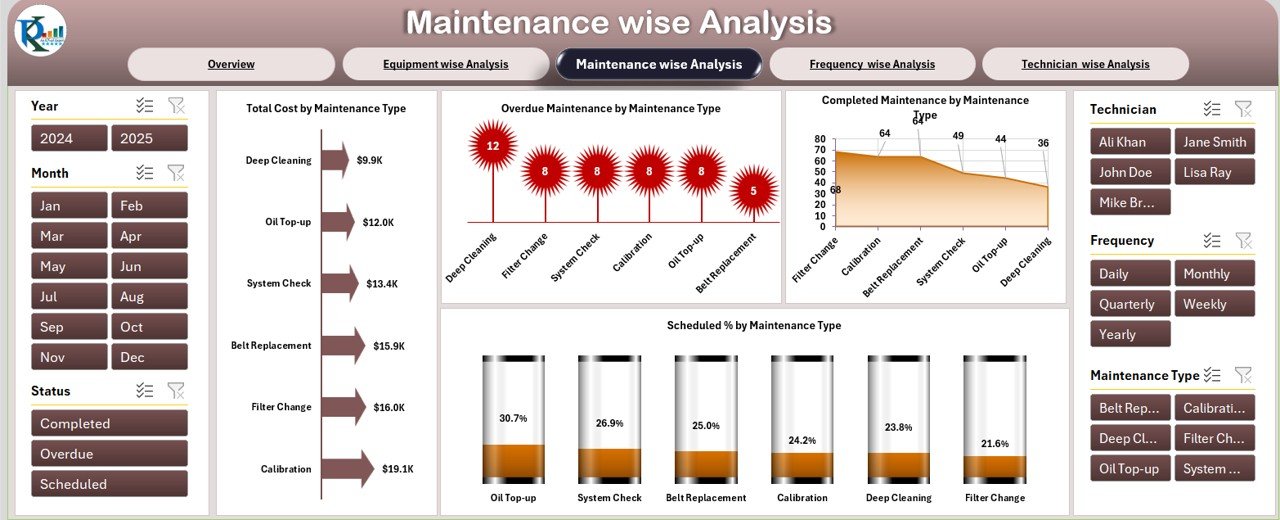
Click to Buy Preventive Maintenance Dashboard in Excel
4. Frequency-Wise Analysis
Maintenance frequency (daily, weekly, monthly, quarterly) impacts workload and cost. Frequency-wise charts include:
-
# of Maintenance by Frequency: Counts the number of maintenance tasks by schedule.
-
Total Cost by Frequency: Displays expenses associated with each frequency type.
-
Completed Maintenance by Frequency: Measures completion rate based on frequency.
-
Overdue % by Frequency: Highlights overdue maintenance by schedule type.
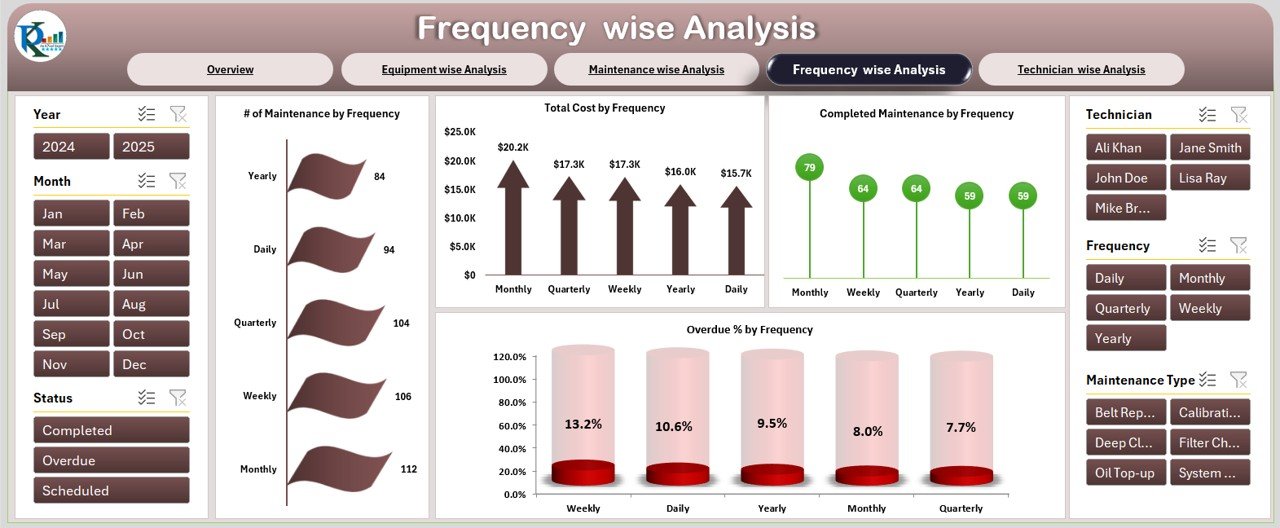
5. Technician-Wise Analysis
Tracking technician performance ensures accountability and efficient resource allocation:
-
# of Maintenance by Technician: Displays the total maintenance tasks handled by each technician.
-
Completed vs Scheduled Maintenance by Technician: Compares planned vs completed tasks for each technician.
-
Overdue % by Technician: Identifies technicians with pending maintenance tasks.
-
Total Cost by Technician: Monitors cost associated with work done by each technician.
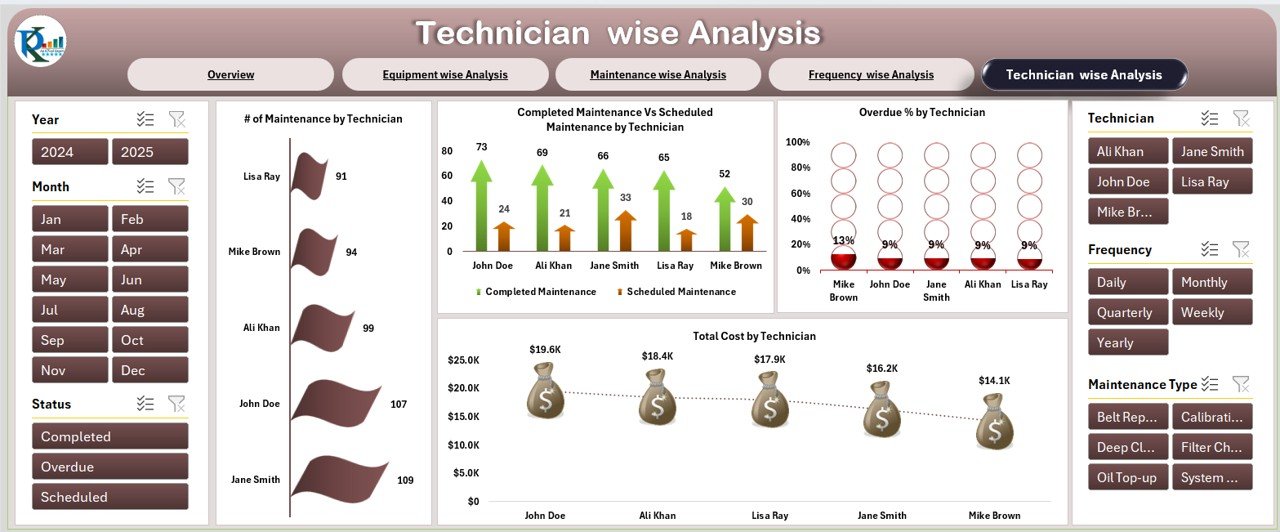
Click to Buy Preventive Maintenance Dashboard in Excel
6. Data Sheet Tab: Centralized Data Input
The Data Sheet is the foundation of the dashboard, where all maintenance records are entered. Columns typically include:
-
Equipment Name: Name of the asset being maintained.
-
Maintenance Type: Type of preventive maintenance performed.
-
Scheduled Date: Planned date for maintenance.
-
Completion Date: Date maintenance was completed.
-
Maintenance Frequency: Daily, weekly, monthly, or yearly schedule.
-
Technician Name: Employee responsible for the task.
-
Status: Completed, Pending, Overdue.
-
Cost: Maintenance expenditure per activity.
-
Remarks: Additional notes related to maintenance tasks.
This sheet allows for structured data entry, which automatically feeds into the dashboard’s visualizations.
Advantages of Using a Preventive Maintenance Dashboard
Click to Buy Preventive Maintenance Dashboard in Excel
-
Centralized Data Management: All maintenance activities and costs are consolidated in one sheet.
-
Real-Time Insights: Monitor maintenance progress, costs, and overdue tasks instantly.
-
Cost Control: Identify high-cost equipment or maintenance types and optimize expenses.
-
Improved Compliance: Ensure scheduled maintenance tasks are completed on time.
-
Technician Performance Tracking: Evaluate performance and assign workloads efficiently.
-
Data-Driven Decisions: Use visual insights to plan maintenance schedules and budgets effectively.
Best Practices for Preventive Maintenance Management
-
Regular Updates: Ensure maintenance records are updated immediately after tasks are performed.
-
Prioritize Overdue Tasks: Focus on overdue maintenance to prevent equipment breakdowns.
-
Use Conditional Formatting: Highlight high-cost equipment or overdue tasks for visibility.
-
Evaluate Frequency: Adjust maintenance frequency based on performance trends and costs.
-
Monitor Technician Workload: Balance tasks among technicians to avoid delays and burnout.
-
Review Trends: Analyze monthly or quarterly trends to optimize the preventive maintenance schedule.
Opportunities for Improvement
Click to Buy Preventive Maintenance Dashboard in Excel
-
Automated Alerts: Notify technicians or managers when maintenance tasks are due or overdue.
-
Integration with ERP Systems: Sync maintenance data with enterprise software for seamless tracking.
-
KPI Dashboard: Include key metrics like cost per equipment, completed maintenance %, and overdue %.
-
Mobile Data Entry: Allow technicians to update maintenance status via mobile for real-time tracking.
-
Customizable Reports: Generate department-wise, equipment-wise, or technician-wise reports for management review.
Conclusion
A Preventive Maintenance Dashboard in Excel is a powerful tool for organizations aiming to optimize maintenance operations, reduce costs, and extend equipment lifespan. By consolidating data, visualizing trends, and tracking performance metrics, this dashboard empowers managers and technicians to make data-driven decisions.
Visit our YouTube channel to learn step-by-step video tutorials
Watch the step-by-step video Demo:
Click to Buy Preventive Maintenance Dashboard in Excel



